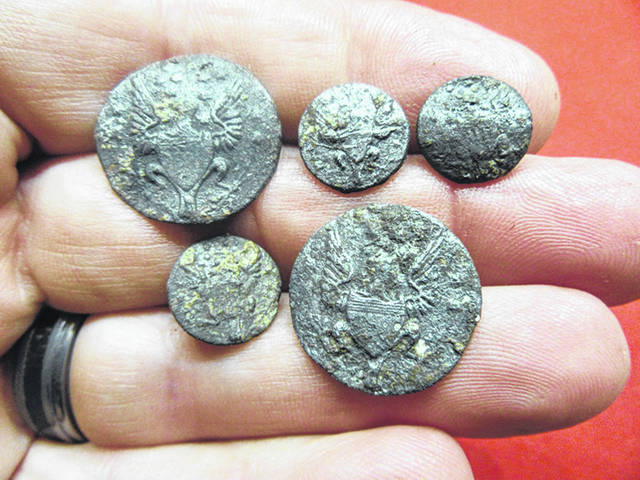
Have you ever gone into the woods to explore? Generations of children spent all day outside searching for anything shiny, bugs, beautiful rocks, unique plants and natural unidentified growth on trees and in the grass. Coming home with a pocket full of treasures was the ending of a glorious day. And most had their own treasure boxes to protect and save their priceless riches.
Treasure boxes can be full of clues to connect the people with the events in the way of artifacts. These describe something crafted that was used for a particular purpose during a much earlier time. Archeologists spend a lifetime looking for priceless treasures to define people and places and events from an earlier time. And in Fort Loramie there are a dedicated group of people who are doing just that.
There will be a number of Shelby County artifact hunters exhibiting collections of their findings for the public to view, Sunday, April 28, at the Fort Loramie Elementary School, in addition to a lecture presented by Greg Shipley in conjunction with the Shelby County Ohio Bicentennial Celebration sponsored by the Fort Loramie Historical Association. The display of collections will be open from 1 to 4 p.m. Shipley’s informational lecture is scheduled to begin at 1 p.m.
Stories are often told about the history of major events in our history by documentation and word of mouth. Even family genealogy goes back even farther than our nation has been established. Marriage licenses, birth certificates, adoption records and death certificates record our existence. But how do we understand the roles of those people who came before us and the parts they play in our history? And for that matter, how can they tell us today about an event itself?
Ken Sowards, former Ohio history teacher at Fort Loramie High School, participates with a group as they sift through the earth on the Fleckenstein farm where Anthony Wayne’s Fort Loramie and Peter Loramie’s trading post stood.
“The village of Fort Loramie takes its name from the Ohio frontier-era fort built by Anthony Wayne during his campaign against the Ohio Indian tribes in the mid-1790s,” said Soward in a written article on the history of Fort Loramie. “The story of the fort comprises only a small portion of the overall history of this important site. This site, on the head waters of the Loramie Creek, has been important since prehistoric times. In addition, the site was involved in the generation-long struggle for control of the Ohio Country, both before and after the American Revolution. Today, surface hunters and metal detector-users scour the fields of the Fleckenstein farm after every rain. Artifacts have been pulled off these fields literally by the thousands. Each of these artifacts tells its small part of a much larger story.”
His interest in archaeology was piqued by a student in 1975 who encouraged him to begin searching for arrowheads. He found his first artifacts and the rest is history.
“In the summer of 2014, a group of artifact hunters began grating and marking off sections of the land where the fort was marked to be,” said Sowards. “The discoveries from that site have provided valuable information concerning the history of Fort Loramie. The group congregates during the summer months for their digs.
“We have found gun parts, bridle parts, locks, keys to a liquor cabinet, buttons from military uniforms and coins, to name a few. The coins we have uncovered include a 1793 penny that was only minted for two years and is one of the first coins ever minted in the United States. And we found several Spanish reals which were accepted as world currency and could be used anywhere in the world. One of my favorite pieces I found was a thimble that had to belong to a child, as the size was so tiny.
“And we have found glass and flint that had gone through a fire. This discovery can confirm the history of Peter Loramie who was pro-Indian and pro-British during the American Revolutionary War. His trading post, which was in business between 1795 and 1782, was reportedly burned to the ground by a Kentucky militia who rode up to destroy the post where Loramie supplied the Indians.”
In addition to these artifacts the group has found a copper tea kettle identical to one that was found in Williamsburg and broken pieces of china kitchenware. Because these hunters have educated themselves and read everything they can find about this time period and physical necessities of every day life, they connect the pieces with the history of the time. And due to their diligence to study the places and people and events, they know that those pieces of broken china came from China to England to Virginia to Ohio. The clues create understanding.
The connections between the clues and the documentations open up the discovery of the facts surrounding our history. And those treasures we find in the earth as children or as adults could be something so much bigger than ourselves and just might be the piece to change a theory into fact.


